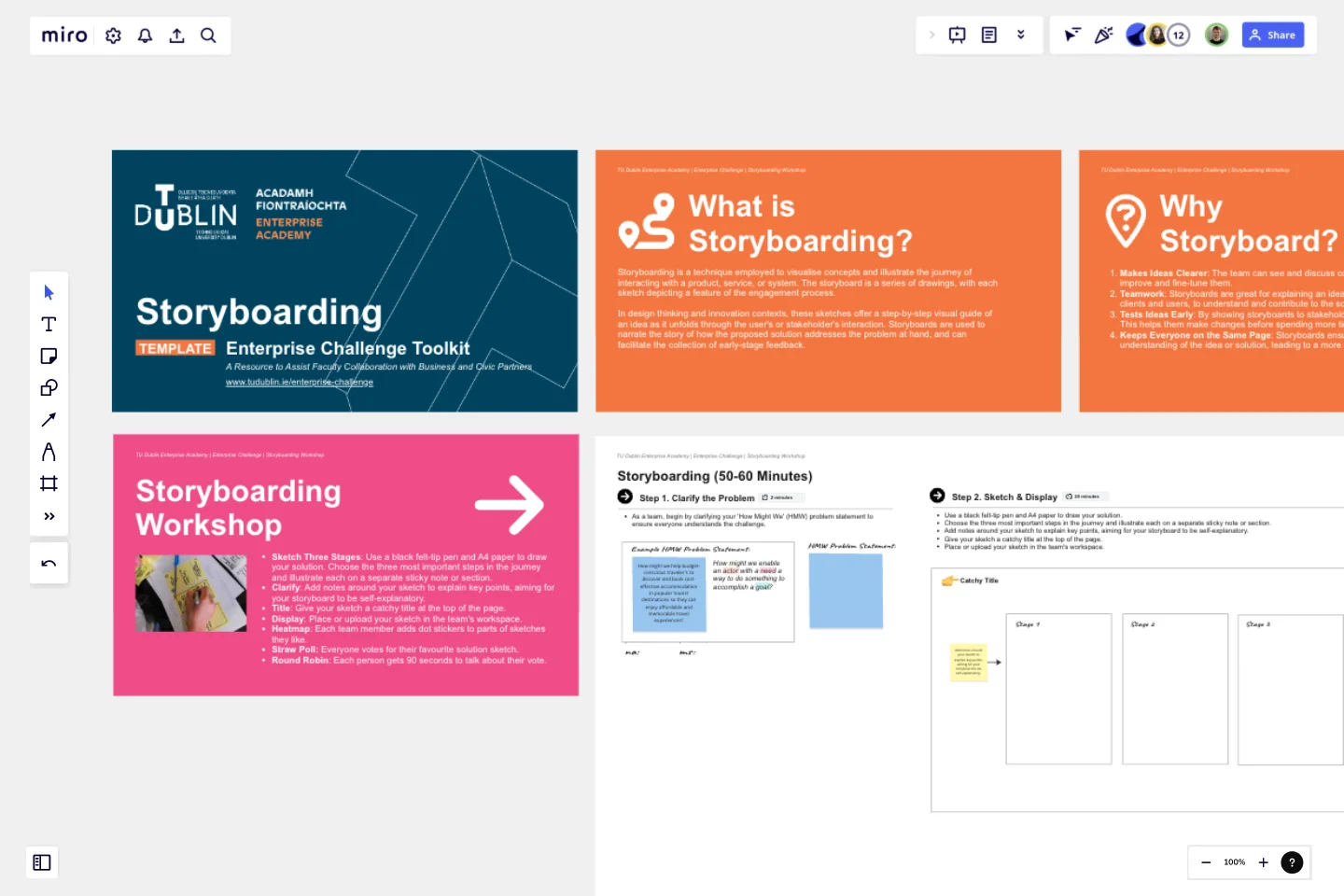The Storyboarding Workshop Template
Storyboards are typically developed either at the end of the Ideation phase or at the start of the Prototype phase.
By visually detailing the ideas, storyboards allow for a clearer understanding and assessment of each proposed solution's potential and practicality.
When to Use
Storyboards are typically developed either at the end of the Ideation phase or at the start of the Prototype phase. By visually detailing the ideas, storyboards allow for a clearer understanding and assessment of each proposed solution's potential and practicality.
How to Use
Sketch Three Stages: Use a black felt-tip pen and A4 paper to draw your solution. Choose the three most important steps in the journey and illustrate each on a separate sticky note or section.
Clarify: Add notes around your sketch to explain key points, aiming for your storyboard to be self-explanatory.
Title: Give your sketch a catchy title at the top of the page.
Display: Place or upload your sketch in the team's workspace.
Heatmap: Each team member adds dot stickers to parts of sketches they like.
Straw Poll: Everyone votes for their favourite solution sketch.
Round Robin: Each person gets 90 seconds to talk about their vote.
Use the vote and discussion to select one sketch for further detailed storyboarding or prototyping.
This template was created by Niamh O'Hora. Discover more storyboard template examples and map your next project.
Get started with this template right now.
Job Map Template
Works best for:
Design, Desk Research, Mapping
Want to truly understand your consumers’ mindset? Take a look at things from their perspective — by identifying the “jobs” they need to accomplish and exploring what would make them “hire” or “fire” a product or service like yours. Ideal for UX researchers, job mapping is a staged process that gives you that POV by breaking the “jobs” down step by step, so you can ultimately offer something unique, useful, and different from your competitors. This template makes it easy to create a detailed, comprehensive job map.
Storyboard for Customer Journey Template
Works best for:
Storyboard
The Storyboard for Customer Journey template lets you map every touchpoint in the customer’s experience, from awareness to post-purchase. Capture customer actions, emotions, and pain points to better understand their journey. Ideal for marketers and CX teams, it reveals opportunities for improving customer satisfaction, driving engagement, and fostering loyalty through strategic insights and data-driven decisions
SUS Evaluation
Works best for:
Design, UX
To assess the emotional experience of users, use the SUS Evaluation Template. This involves conducting a survey with a set of questions where respondents rate their level of agreement on a scale ranging from 'Strongly Disagree' to 'Strongly Agree.' These questions evaluate various aspects of the user experience, such as ease of use, aesthetics, and overall satisfaction. This approach is valuable for comparing design iterations and evaluating the effectiveness of products and services.
Cluster Analysis Template
Works best for:
Design
When you're working with others, you might encounter situations where there's too much information to handle, or you're unsure about the direction to take. In such cases, using the Cluster Analysis Template can be helpful. It allows you to group similar items together and make sense of them, whether feedback or creative ideas. This method is straightforward and provides clarity amidst confusion.
Design Research Template
Works best for:
UX Design, Design Thinking, Desk Research
A design research map is a grid framework showing the relationship between two key intersections in research methodologies: mindset and approach. Design research maps encourage your team or clients to develop new business strategies using generative design thinking. Originally designed by academic Liz Sanders, the framework is meant to resolve confusion or overlap between research and design methods. Whether your team is in problem-solving or problem space definition mode, using a research design template can help you consider the collective value of many unrelated practices.
Stakeholder Analysis Template
Works best for:
Design
When designing new solutions, thinking about what people need is important. Before deciding or defining the problem, ask questions like: Who is involved? What do they care about? How much power do they have? Understanding how your work affects everyone involved is crucial. Stakeholder analysis helps you plan and might change how you see the problem.
